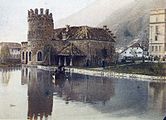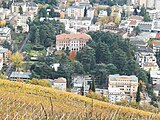Villa Wendlandt
The Villa Wendlandt was an upper-class residential building in Bozen - Gries with a large park.
history
The Scholvien family from Hamburg moved to Bozen around 1850 and bought the Compil residence in 1855 . Minna Ottilie Scholvien-Wendlandt (1930–1907) sold the residence in 1869 and temporarily moved into the Rottenbuch residence . In 1872 she commissioned the Munich architect Gottfried von Neureuther to plan a new villa. In 1874 the building in the neo-renaissance style was completed; it was surrounded by an extensive park with a pond and a (still existing) ruin castle in the Tudor style . Wendlandt supported the Bozen-Gries Kurverein, founded in 1874, and built an inn on the north side of their park in 1888 - the Hotel Sonnenhof , the most luxurious building on the site at the time (today's student residence). In 1891, today's Egger-Lienz-Strasse was named Wendlandtstrasse in her honor . The Villa Wendlandt developed into a literature salon and meeting place for cosmopolitan circles. The Wendtlandts also played a key role in building the Evangelical Christ Church in Gries in the early 20th century.
Since they were Reich Germans, the family was expropriated by the Italian state after the First World War . Villa and park were transferred to the Opera Nazionale Combattenti in 1924 ; the previous owners were allowed to stay in the house as tenants until 1931. For propaganda reasons, Benito Mussolini wanted to order a member of the Italian royal family to Bolzano. His choice fell on Filiberto di Savoia-Genova , Duke of Pistoia . In 1932 the renovation of the Villa Wendlandt began, which was almost completely demolished and, in the fascist taste of the 1930s, based on a project by Federico Forlati, was built much more spacious than the Duke's residence. On October 28, 1934 - the year day of the March on Rome - which was Ducal Palace inaugurated. The Savoy did not even stay in the house for ten years, however, as he fled the invading German Wehrmacht in 1943 and never returned. During the Alpine Foreland operational zone from 1943 to 1945, the Ducal Palace was used by the German authorities under SS General Karl Wolff . It stood empty until 1958, when it finally became the seat of the government commissioner of the province of Bolzano .
The park is open to the public today. In 1999, the Bolzano City Archives showed an exhibition on the Wendlandt Villa, which raised awareness of the importance of the Villa and the Wendlandt family for the city.
literature
- Stefano Consolati, Ferruccio Delle Cave (ed.): Villa Wendlandt. (Exhibition catalog of the city gallery, March 26 to May 29, 1999) (= booklets on the history of Bolzano , volume 1.) Bolzano City Archives , Bozen 1999.
- Hannes Obermair : “City in transition” - the Bolzano example “revisited”. In: Razionalismi. Percorsi dell'abitare - Living appropriately, Bolzano / Bozen 1930–40. Bolzano: La Fabbrica del Tempo / Die Zeitfabrik 2015, pp. 35–40, doi: 10.13140 / RG.2.1.2831.5927 .
- Hans H. Reimer: Lutheran in South Tyrol. History of the Evangelical Congregation Meran. A search for traces of Protestantism in South Tyrol and Trentino. Edition Raetia, Bozen 2009, ISBN 978-88-7283-332-2 .
- Maurizio Urzì: Palazzo ducale di Bolzano. Manfrini Editori, Calliano 1989.
Web links
- The exhibition on Villa Wendlandt in the city gallery
- The Ducal Palace on the government commissioner's website
Coordinates: 46 ° 30 ′ 17.8 " N , 11 ° 20 ′ 21.4" E





